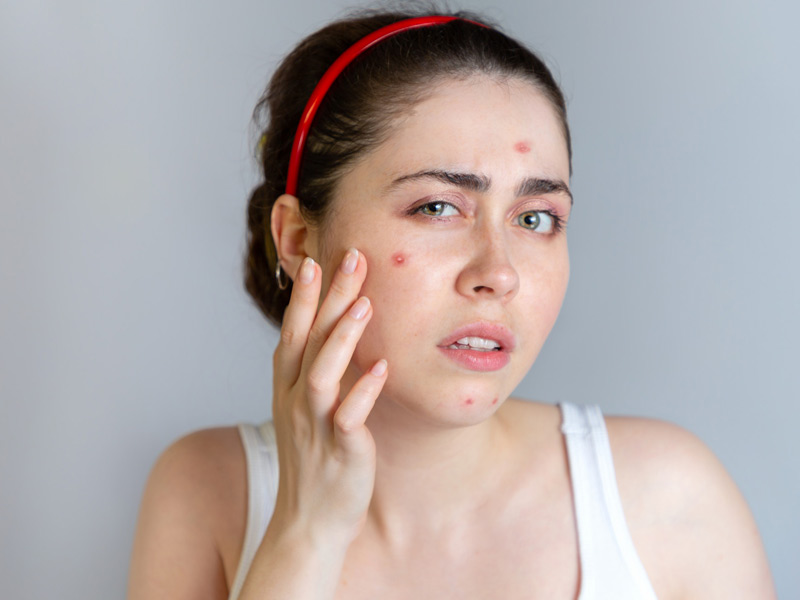
Acne is one of the most common skin problems most people face, especially those with oily skin. Acne is usually associated with hormonal fluctuations, which a person experiences during the teenage years, but adults can experience acne, too. Acne is one of the most common skin problems among children and adults. The term ‘breakout’ is commonly used to describe all forms of acne, but this isn’t always the most accurate description because not all types of acne spread across the skin. There are numerous types of acne that you should know about. We have mentioned them all in this article so give it a read till the end.
Table of Content:-
Acne is generally caused because of clogged pores. Wearing too much makeup, sleeping with the makeup on, not washing the face properly, and not keeping the skin hydrated are some reasons for clogged pores. These lead to:
- excess production of oil, actually called sebum
- bacteria
- hormones
- dead skin cells
- ingrown hairs
Types of Acne On Face
Acne also has different types. According to skincare expert Anish Nagpal, Co-founder Dermatouch, identifying, firstly, which kind of acne you’re experiencing is key to successful treatment. Acne may be noninflammatory or inflammatory. Subtypes of acne within these two categories include:
Also Read: Try Out These Natural Supplements to Reduce Acne Scars
1) Acne Vulgaris
It is the name for common acne which is found in prevalent spots. They may seem ordinary but may also become severe in some instances. If the breakout becomes very painful, you may need to see a ermatologist.

2) Comedones
A comedo, or primary acne lesion, is a hair follicle that becomes clogged with oil and dead skin cells. Comedones can develop into bumps, which are known as whiteheads and blackheads. Products that may trigger comedones are called "comedogenic." Makeup products labeled "non-comedogenic" are less likely to clog pores and contribute to different types of acne.
3) Black Heads
Blackheads are comedones that are open at the surface of the skin. They are filled with excess oil and dead skin cells. It's not dirt that turns the comedone black. The black color results from the irregular reflection of light coming from clogged hair follicles. The treatments of blackheads can be done with over-the-counter medications.
Also Read: A Guide To Non-Comedogenic Oils That Doesn’t Clog The Pores
4) Whiteheads
Whiteheads are closed skin pores or hair follicles clogged with oil, dead skin cells, and bacteria. They occur when a hair follicle/sebaceous gland becomes inflamed. Inflammation can occur because of increased sebum production and abnormal keratin formation.
5) Papules
Papules are comedones that become inflamed, forming small red or pink bumps on the skin. These types of bumps may be sensitive to the touch. Picking or squeezing them can worsen the inflammation and lead to scarring. Having many papules may indicate moderate to severe acne.

6) Nodules
Nodules are large, inflamed bumps that feel firm when touched. They develop deep within the skin and are often painful. Nodules are advised to be treated by a dermatologist since they can scar. Over-the-counter treatments may not be strong enough to clear them up, but prescription drugs can be effective.
Also Read: Why Are Salicylic Acid Cleansers So Popular For Acne-Prone Skin?
7) Mild and Moderate Acne
Acne is in the "mild" category if you have fewer than 20 whiteheads or blackheads, fewer than 15 inflamed bumps, or fewer than 30 total lesions. Mild acne is usually treated with over-the-counter topical medicine. It may take up to eight weeks to see a significant improvement.
If you have 20 to 100 whiteheads or blackheads, 15 to 50 inflamed bumps, or 30 to 125 total lesions, your acne is moderate. Generally, dermatologists recommend prescription medication for moderate to severe acne. It may take many weeks to notice an improvement, and your acne may even worsen before it gets better.
Acne Treatment
No one likes to have a scarred face. Acne scars and marks ruin the face and make people less confident about their appearance. We all try treating acne by ourselves or watching some videos on YouTube etc. But, since the skin type differs from person to person, a treatment that works well for one person may not work well in the other person's case. Therefore, a doctor's prescription is advised before you start the treatment independently.
Here are some treatments for acne that dermatologists most commonly use:
- Retinoids and retinoid-like drugs- They are used in case of moderate acne. It is advised to apply them three times a week. Limited use is recommended because it might increase sensitivity to the sun.
- Antibiotics- Antibiotics kill bacteria and reduce inflammation. It is best if they are applied with retinoids to start the treatment.
- Azelaic acid and salicylic acid- These acids are naturally occurring, produced by yeast.20% Azelaic acid with Salicylic is recommended to be applied twice a day. They help in managing the discoloration which happens due to acne.
- Dapsone- It is a gel that is especially recommended for women. It's advised to apply it twice a day.
Conclusion
There are different types of acne that require different treatment. If you are not getting relief in breakouts and flareups, you must analyze what kind of acne you have. Probably, you are treating it the wrong way. If you experience severe acne, you must see a good dermatologist for proper medical aid.
Image credits- freepik
Also watch this video
How we keep this article up to date:
We work with experts and keep a close eye on the latest in health and wellness. Whenever there is a new research or helpful information, we update our articles with accurate and useful advice.
Current Version